高中英语新课标人教版必修4 Unit 4 Body language warming up课件 (共35张PPT)
文档属性
| 名称 | 高中英语新课标人教版必修4 Unit 4 Body language warming up课件 (共35张PPT) | 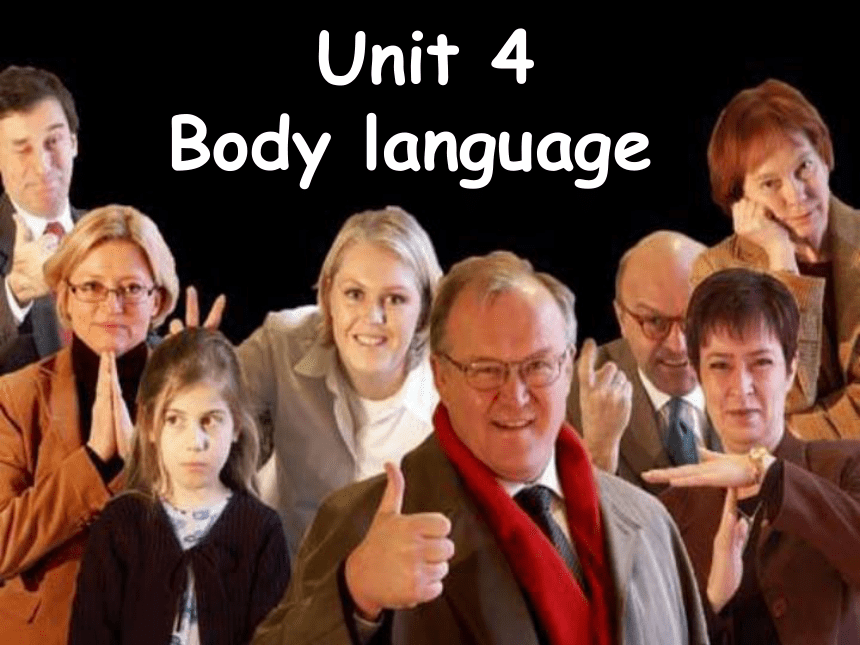 | |
| 格式 | zip | ||
| 文件大小 | 3.0MB | ||
| 资源类型 | 教案 | ||
| 版本资源 | 人教版(新课程标准) | ||
| 科目 | 英语 | ||
| 更新时间 | 2018-12-14 09:40:55 | ||
图片预览


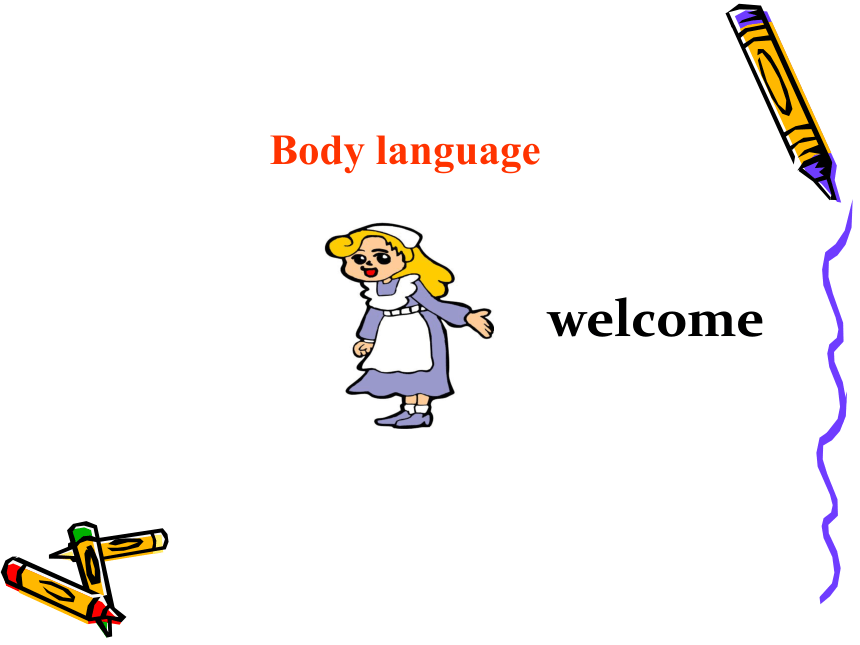
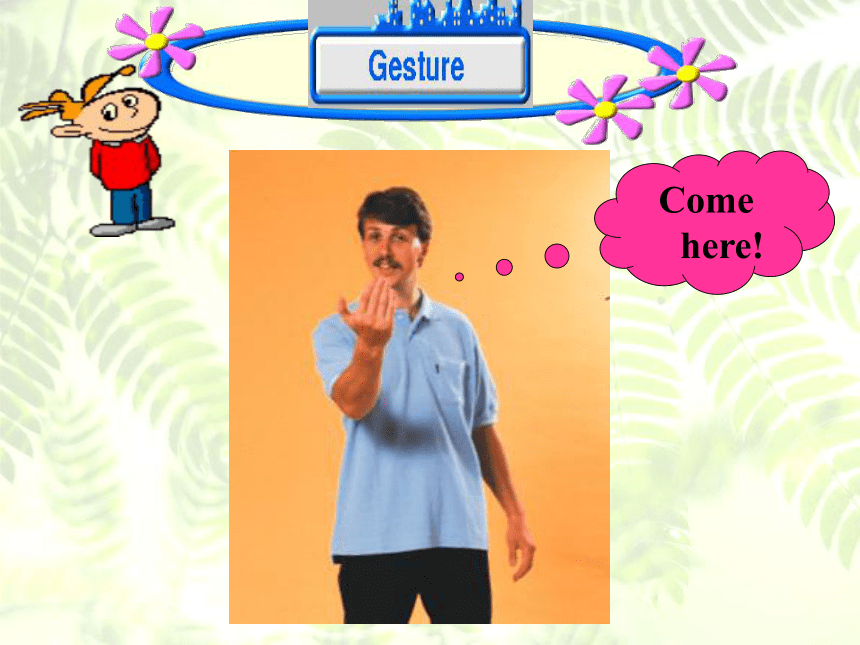
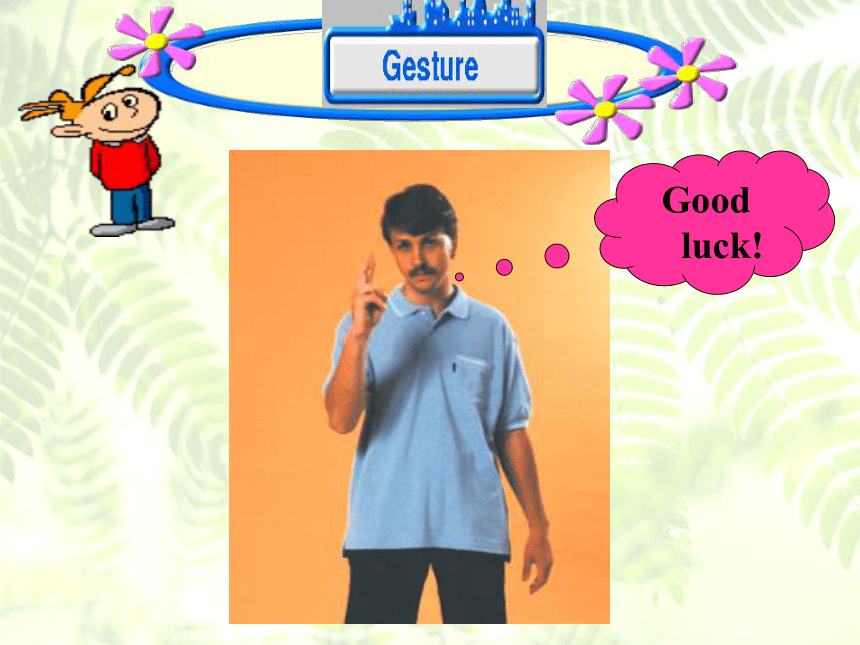
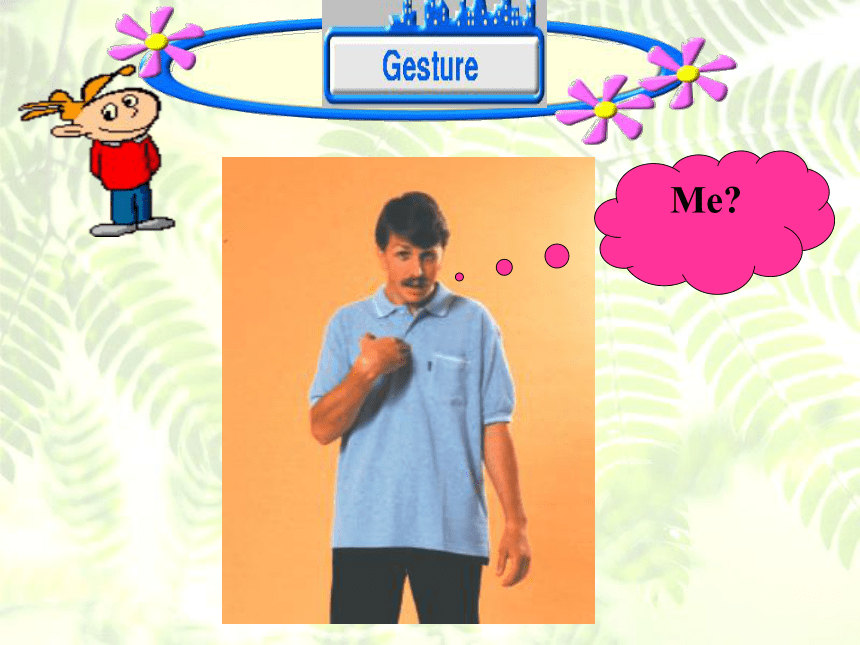
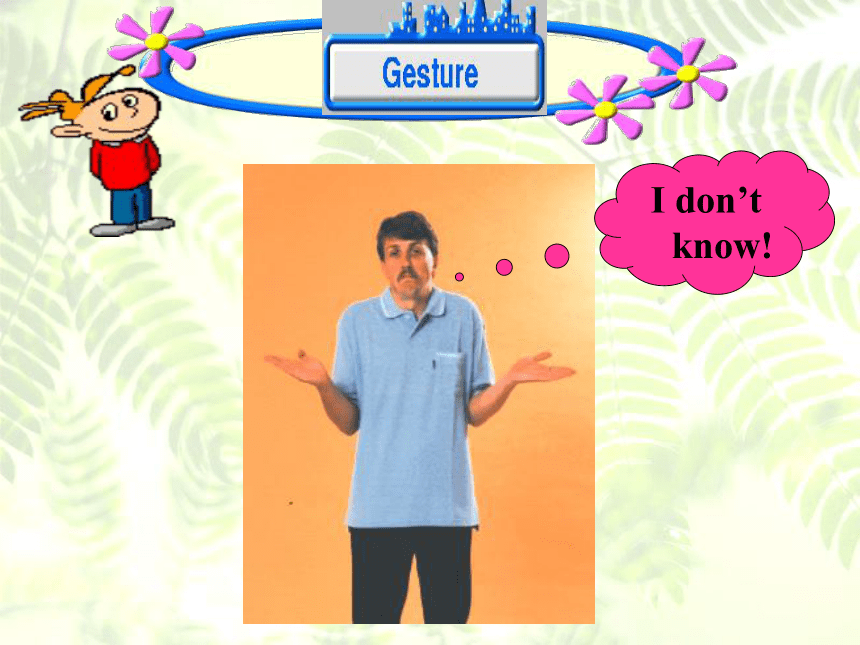
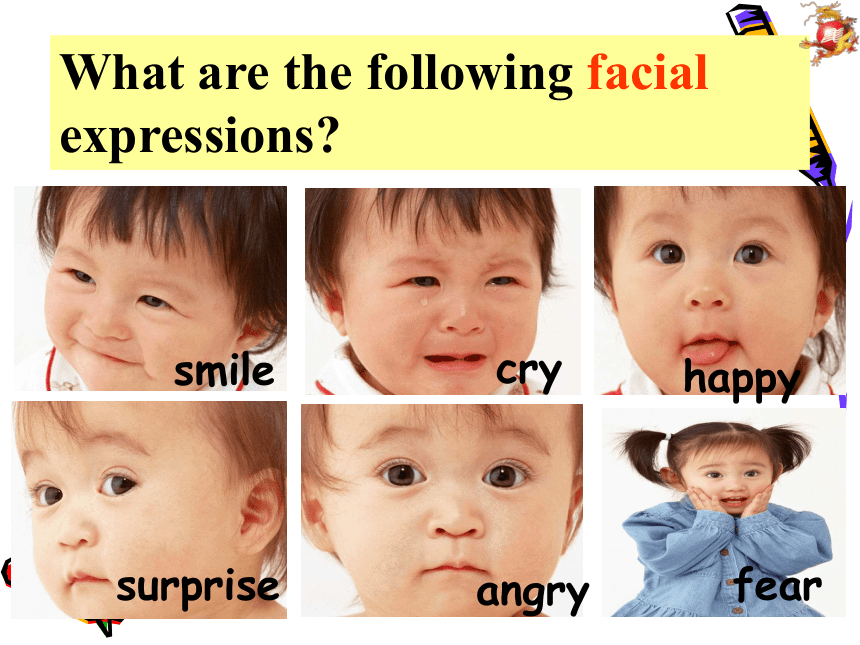



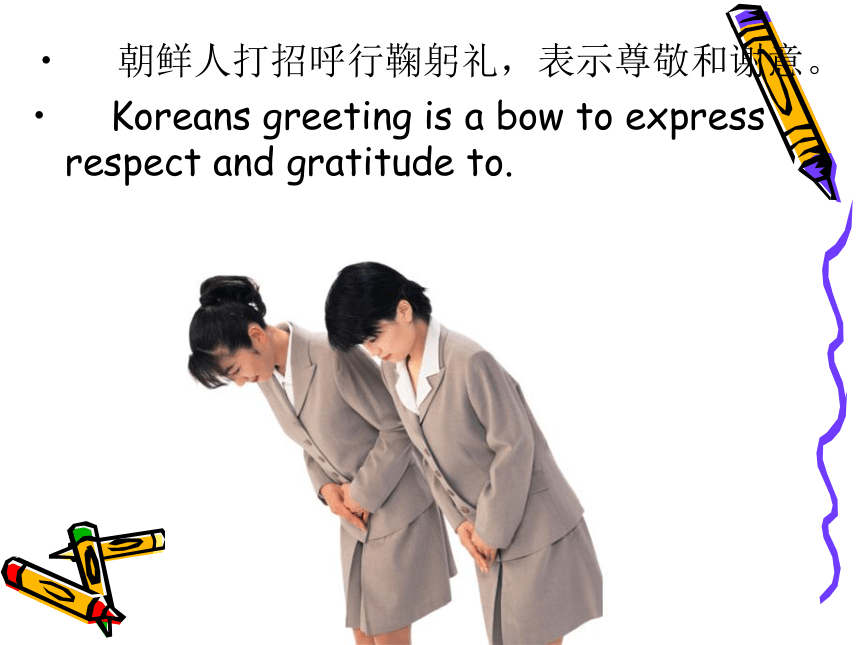
文档简介
课件35张PPT。 Unit 4
Body language speakingringingwritingtypingSpoken languageWritten languageWays of communicatingBody languagewelcomeGuessCome here!
GuessGood luck!
GuessMe?
GuessI don’t know!
smilecrysurpriseangryhappyfearWhat are the following facial expressions?shake one’s hand
(handshake n.)hug kiss nod at sb.Bow to sb.In China, Britain
In Russia, France,
In Arab, Japan, Korea
In Some western countries Shake hands
Kiss
Bow
hugWhat do people usually do when meeting? 朝鲜人打招呼行鞠躬礼,表示尊敬和谢意。
Koreans greeting is a bow to express respect and gratitude to. 泰国人打招呼男士双手在额前,女士双手在胸前。
Thai , the male places hands in facial front, female before then placing at the chest to each other.日本人以脱帽子鞠躬来打招呼,稍微低头,眼睛向下。
Hats off the Japanese in order to say hello, slightly bowed and eyes down.Australian italian person to shake hands to say hello.
澳大利人打招呼是握手。马来西亚打招呼是两人双手交窝,双手微触额头一下,双手微触胸前一下。
Malaysia, the two people hands hand over to hold for a whlie . the hands are tiny to touch a forehead and before the chest for a whlie.Indonesian's friends is to press down a chest to say hello each other with the right hand, to ordinary people then to shake hands.
印尼人熟人是用右手按住胸口互相问好,对一般人则以握手问好。一般说来,男士之间,主要是边握手边打招呼。 关系比较好的女士之间,或男女间,就主要采取贴面礼或亲吻礼。根据不同地方的习惯,有人亲吻两下,左脸右脸;有人则更多。
贴面礼,其实只是脸靠脸,嘴巴发出亲吻的声音而已。那亲吻礼就是直接脸上“啵”“啵”左右脸两下,直接亲了。 France南亚摇头礼在印度、巴基斯坦、孟加拉、尼泊尔、斯里兰卡等国,人们相互交往时,往往彬彬有礼地摇头。他们的表敬礼俗是:向左摇头则表示赞同、尊重或认可;点头则表示不同意。这恰恰与中国的"摇头不算点头算"相反. 碰鼻礼是毛利人与外来客人的见面礼。依照传统,是由部落中最德高望重的长者走向客人,以毛利人致宾客的最高礼节和客人碰鼻子。即双方将鼻尖对鼻尖地相碰两三次,然后再分开。碰鼻的时间越长,说明客人受到的礼遇越高。 毛利人认为人的灵气在头部,通过突出的鼻尖可以与别人相通,碰鼻一下是互相通神,碰鼻两下表示在一起呼吸和生存,有相亲和友好的意思。碰鼻过后,迎宾仪式即告结束。在西亚与北非沙漠地区一些国家的人、毛里求斯以及新西兰的毛利人,彼此见面习惯用碰鼻礼。
ReadingCommunication:
No problem?
C) to meet international students at Capital International Airport.A) Summary of body language.B) Different cultures, different body languages. D) Examples of cultural “body language”.(Para1)(Para 2 and 3) (Para 4)(Para5)Part 1 :Part 2:Part 3:Part 4: careful reading Para11 . Who did another student and I meet at the airport?
2 . Why were they visiting China?International students
They were coming to study at Beijing University.
Para2: Find out the two cultural mistakes the author found at the airport:Tony Garcia Julia SmithThe first cultural mistakefromfrom(Columbia )(Britain)He approached Julia , _______ ______ _________ and _______ her on the ________.She ______ ________ appearing _________ and put up her hands, as if in _________.shouldertouchedherkissedcheekstepped backsurpriseddefenceThe second
cultural
mistakeAkira Nagata
fromGeorge Cookfrom(Canada)He ________ ________ _______ ________ to the Japanese.He ________ to Mr. Cook and his nose _________ George’s _______ ________.bowedtouchedmovinghandreached his handout(Japan)Tony Garcia (Columbia)
Julia Smith (Britain)
Akira Nagata (Japan)
George Cook (Canada)
Darlene Coulon (France)Matching the people and their different ways of greeting (para2&3)shakes hands and kisses others twice on each cheek
bows
shakes hands
approaches others closely and touches their shoulder and kisses them on the cheek
does not stand very close to others or touch strangers Part 2_________others closely and are more likely to__________.Do not stand _________to others or touch ________ when they meet. BowShake handsFill in the table according to Para4:very closestrangersApproachtouch themSome body language is similar in most countries.As one coin has two sidesSome body language is
in
different countries.
differenta way to show
one’s interestrude or
disrespectfuleye contactsome countriesother countriesThumbs-upNigeriathe number
onegreat or good jobthe USGermanyJapanrudeJapanZeroBrazilGermanymaking a circle
with one’s
thumb and
index fingerOKmost countriesMoneyFranceRudecrazyYou have a
phone call.moving the index finger in a circle
in front of the earsome countriesBrazil______language is __________ from culture to ________. Not all ________of a culture ________in the ______ way.In general, _________ international customs can certainly help ________ difficulties in the cultural communication.Bodydifferentculturemembersbehavesame studyingavoidSummaryThank you
Body language speakingringingwritingtypingSpoken languageWritten languageWays of communicatingBody languagewelcomeGuessCome here!
GuessGood luck!
GuessMe?
GuessI don’t know!
smilecrysurpriseangryhappyfearWhat are the following facial expressions?shake one’s hand
(handshake n.)hug kiss nod at sb.Bow to sb.In China, Britain
In Russia, France,
In Arab, Japan, Korea
In Some western countries Shake hands
Kiss
Bow
hugWhat do people usually do when meeting? 朝鲜人打招呼行鞠躬礼,表示尊敬和谢意。
Koreans greeting is a bow to express respect and gratitude to. 泰国人打招呼男士双手在额前,女士双手在胸前。
Thai , the male places hands in facial front, female before then placing at the chest to each other.日本人以脱帽子鞠躬来打招呼,稍微低头,眼睛向下。
Hats off the Japanese in order to say hello, slightly bowed and eyes down.Australian italian person to shake hands to say hello.
澳大利人打招呼是握手。马来西亚打招呼是两人双手交窝,双手微触额头一下,双手微触胸前一下。
Malaysia, the two people hands hand over to hold for a whlie . the hands are tiny to touch a forehead and before the chest for a whlie.Indonesian's friends is to press down a chest to say hello each other with the right hand, to ordinary people then to shake hands.
印尼人熟人是用右手按住胸口互相问好,对一般人则以握手问好。一般说来,男士之间,主要是边握手边打招呼。 关系比较好的女士之间,或男女间,就主要采取贴面礼或亲吻礼。根据不同地方的习惯,有人亲吻两下,左脸右脸;有人则更多。
贴面礼,其实只是脸靠脸,嘴巴发出亲吻的声音而已。那亲吻礼就是直接脸上“啵”“啵”左右脸两下,直接亲了。 France南亚摇头礼在印度、巴基斯坦、孟加拉、尼泊尔、斯里兰卡等国,人们相互交往时,往往彬彬有礼地摇头。他们的表敬礼俗是:向左摇头则表示赞同、尊重或认可;点头则表示不同意。这恰恰与中国的"摇头不算点头算"相反. 碰鼻礼是毛利人与外来客人的见面礼。依照传统,是由部落中最德高望重的长者走向客人,以毛利人致宾客的最高礼节和客人碰鼻子。即双方将鼻尖对鼻尖地相碰两三次,然后再分开。碰鼻的时间越长,说明客人受到的礼遇越高。 毛利人认为人的灵气在头部,通过突出的鼻尖可以与别人相通,碰鼻一下是互相通神,碰鼻两下表示在一起呼吸和生存,有相亲和友好的意思。碰鼻过后,迎宾仪式即告结束。在西亚与北非沙漠地区一些国家的人、毛里求斯以及新西兰的毛利人,彼此见面习惯用碰鼻礼。
ReadingCommunication:
No problem?
C) to meet international students at Capital International Airport.A) Summary of body language.B) Different cultures, different body languages. D) Examples of cultural “body language”.(Para1)(Para 2 and 3) (Para 4)(Para5)Part 1 :Part 2:Part 3:Part 4: careful reading Para11 . Who did another student and I meet at the airport?
2 . Why were they visiting China?International students
They were coming to study at Beijing University.
Para2: Find out the two cultural mistakes the author found at the airport:Tony Garcia Julia SmithThe first cultural mistakefromfrom(Columbia )(Britain)He approached Julia , _______ ______ _________ and _______ her on the ________.She ______ ________ appearing _________ and put up her hands, as if in _________.shouldertouchedherkissedcheekstepped backsurpriseddefenceThe second
cultural
mistakeAkira Nagata
fromGeorge Cookfrom(Canada)He ________ ________ _______ ________ to the Japanese.He ________ to Mr. Cook and his nose _________ George’s _______ ________.bowedtouchedmovinghandreached his handout(Japan)Tony Garcia (Columbia)
Julia Smith (Britain)
Akira Nagata (Japan)
George Cook (Canada)
Darlene Coulon (France)Matching the people and their different ways of greeting (para2&3)shakes hands and kisses others twice on each cheek
bows
shakes hands
approaches others closely and touches their shoulder and kisses them on the cheek
does not stand very close to others or touch strangers Part 2_________others closely and are more likely to__________.Do not stand _________to others or touch ________ when they meet. BowShake handsFill in the table according to Para4:very closestrangersApproachtouch themSome body language is similar in most countries.As one coin has two sidesSome body language is
in
different countries.
differenta way to show
one’s interestrude or
disrespectfuleye contactsome countriesother countriesThumbs-upNigeriathe number
onegreat or good jobthe USGermanyJapanrudeJapanZeroBrazilGermanymaking a circle
with one’s
thumb and
index fingerOKmost countriesMoneyFranceRudecrazyYou have a
phone call.moving the index finger in a circle
in front of the earsome countriesBrazil______language is __________ from culture to ________. Not all ________of a culture ________in the ______ way.In general, _________ international customs can certainly help ________ difficulties in the cultural communication.Bodydifferentculturemembersbehavesame studyingavoidSummaryThank you
同课章节目录
